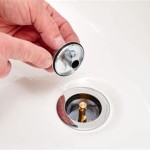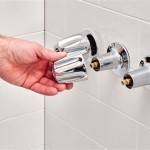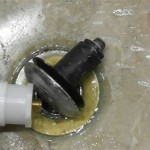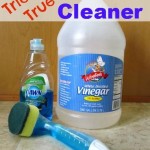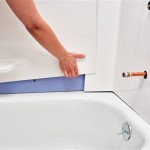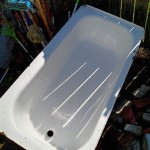Easiest Ways to Clean a Bathtub: A Comprehensive Guide
Maintaining a clean bathtub is essential for hygiene and overall bathroom aesthetics. However, the task can often seem daunting, especially with the build-up of soap scum, hard water stains, and mildew. This article provides a detailed exploration of the most effective and easiest methods for cleaning a bathtub, utilizing readily available household products and minimizing the need for harsh chemicals.
The frequency of bathtub cleaning depends on usage. Bathtubs used daily require more frequent attention than those used sparingly. A weekly or bi-weekly cleaning schedule is generally recommended to prevent stubborn stains and grime accumulation. Preparation is also crucial. Gathering the necessary cleaning supplies before beginning ensures a more efficient and streamlined process.
Key Point 1: Leveraging the Power of Baking Soda and Vinegar
Baking soda and vinegar represent a potent and readily available cleaning combination. Their mild abrasiveness and acidic properties, respectively, work synergistically to dissolve soap scum and eliminate mildew. This method is generally safe for most bathtub surfaces, but a small, inconspicuous test area is always recommended before applying it to the entire tub.
Begin by rinsing the bathtub with warm water. This helps to loosen surface dirt and debris and prepares the surface for the cleaning solution. Next, sprinkle a generous amount of baking soda evenly across the damp surface of the bathtub. Ensure complete coverage, particularly in areas with visible stains or grime.
Following the baking soda application, pour white vinegar into a spray bottle. Spray the vinegar directly onto the baking soda-covered surface. A noticeable fizzing reaction will occur. This effervescence is the chemical reaction between the baking soda (a mild alkali) and the vinegar (an acid), which aids in loosening and lifting the dirt and grime.
Allow the baking soda and vinegar mixture to sit for at least 30 minutes. For particularly stubborn stains, extending the soaking time to an hour or even overnight may be necessary. This extended contact time allows the solution to penetrate and dissolve the grime more effectively.
After soaking, use a non-abrasive sponge or scrub brush to thoroughly scrub the bathtub. Pay close attention to areas around the drain, faucet, and any textured surfaces. The baking soda acts as a gentle abrasive, while the vinegar continues to dissolve the soap scum and hard water deposits. Rinse the bathtub thoroughly with warm water to remove all traces of the baking soda and vinegar solution. Ensure no residue remains, as this can attract dirt and leave a dull film.
Finally, dry the bathtub with a clean towel. This helps prevent water spots and further buildup of grime. Regularly wiping down the bathtub after each use can significantly reduce the need for extensive cleaning.
Key Point 2: Utilizing Dish Soap and Warm Water for Routine Cleaning
For routine maintenance and light cleaning, dish soap and warm water provide a simple yet effective solution. Most dish soaps are formulated to cut through grease and grime, making them suitable for removing soap scum and everyday dirt from the bathtub surface. This method is particularly useful for bathtubs that are cleaned regularly and do not have significant buildup.
Begin by filling a bucket or container with warm water. Add a squirt of dish soap to the water and mix thoroughly to create a sudsy solution. The amount of dish soap required will depend on the concentration of the soap itself; generally, a teaspoon or two is sufficient for a standard-sized bucket of water.
Using a sponge or soft cloth, apply the soapy water to the entire surface of the bathtub. Work in sections, ensuring that all areas are adequately covered. For hard-to-reach areas, such as corners or around the faucet, a small brush or toothbrush can be useful.
After applying the soapy water, scrub the bathtub gently but thoroughly. Focus on areas with visible dirt or soap scum. Avoid using excessive force, as this can damage the bathtub's surface. Allow the soapy water to sit on the surface for a few minutes before rinsing.
Rinse the bathtub thoroughly with warm water to remove all traces of the soap. Ensure that no soapy residue remains, as this can leave a slippery film. Repeat the rinsing process if necessary. Use a clean, dry towel to dry the bathtub thoroughly. This helps to prevent water spots and discourages the growth of mildew.
This method is best suited for regular maintenance and preventative cleaning. For more significant buildup or stains, alternative cleaning methods may be required.
Key Point 3: Addressing Stubborn Stains with Specific Solutions
Despite regular cleaning, bathtubs can sometimes develop stubborn stains that require more targeted solutions. These stains can be caused by hard water, rust, or mildew. Identifying the type of stain is crucial for selecting the most effective cleaning agent.
For hard water stains, a solution of lemon juice or vinegar can be highly effective. These acidic liquids help to dissolve the mineral deposits that cause hard water stains. Apply lemon juice or vinegar directly to the affected area and allow it to sit for approximately 30 minutes. Scrub with a non-abrasive sponge or cloth and rinse thoroughly with water.
Rust stains can be particularly challenging to remove. A paste made from baking soda and lemon juice can be used to treat rust stains. Mix baking soda and lemon juice to form a thick paste. Apply the paste to the rust stain and allow it to sit for several hours or overnight. Scrub the area with a brush and rinse thoroughly with water. In severe cases, a commercial rust remover may be necessary, but always follow the manufacturer's instructions carefully.
Mildew can thrive in the damp environment of a bathtub. A solution of bleach and water is often used to kill mildew. Mix one part bleach with ten parts water. Apply the solution to the mildew-affected area and allow it to sit for approximately 10 minutes. Rinse thoroughly with water. It is essential to ensure adequate ventilation when using bleach, as it can release harmful fumes. Wearing gloves and eye protection is also recommended.
If bleach use is undesirable, hydrogen peroxide can be employed as an alternative. Spray hydrogen peroxide on the mildewed area, let it sit for 10-15 minutes, then scrub and rinse. This is a gentler approach than bleach, but may require multiple applications.
For any specialized cleaning solution, it is imperative to test the product on an inconspicuous area of the bathtub first to ensure it does not damage the surface. Proper ventilation is also crucial when using any cleaning agent, particularly those with strong odors or chemical properties. Always wear appropriate protective gear, such as gloves and eye protection, to avoid skin and eye irritation.
In addition to the methods outlined above, several commercial bathtub cleaning products are available. These products are often formulated with specific ingredients to target particular types of stains or grime. When selecting a commercial cleaning product, consider the type of bathtub material and the severity of the stains. Always follow the manufacturer's instructions carefully and test the product on an inconspicuous area before applying it to the entire bathtub.
Preventive measures play a crucial role in maintaining a clean bathtub. Regularly wiping down the bathtub after each use helps prevent the buildup of soap scum and water spots. Ensuring adequate ventilation in the bathroom can also help to reduce the growth of mildew. Addressing small stains and grime promptly can prevent them from becoming stubborn and difficult to remove.
Choosing the right cleaning tools is also important. Non-abrasive sponges, soft cloths, and brushes are generally recommended for cleaning bathtubs. Avoid using abrasive scrub brushes or scouring pads, as these can scratch or damage the bathtub's surface. A long-handled brush can be helpful for reaching hard-to-reach areas and reducing the need to bend over.
Implementing these strategies and techniques for bathtub cleaning will significantly improve the hygiene and appearance of the bathroom. Regular maintenance and careful attention to detail will ensure a clean and inviting bathing environment.

How To Clean Bath Toys Best Tips For Cleaning Today
Related Posts

